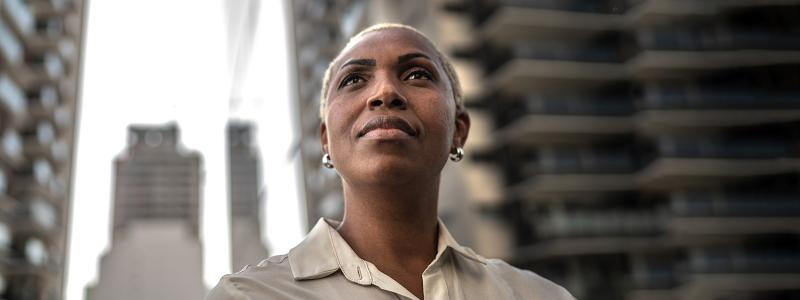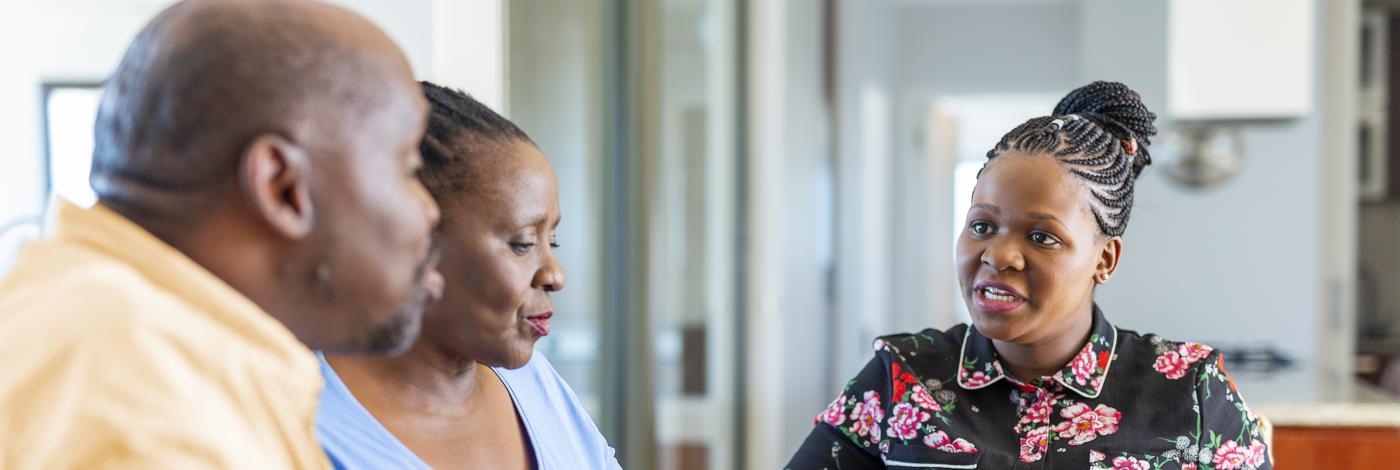Make Black History Month a Charge to Effect Real, Lasting Change

Aside from my attraction to history, the payoff from this framing comes in Woodson’s profound words at the time of Negro History Week’s launch in 1926, when he said, “If a race has no history, it has no worthwhile tradition, it becomes a negligible factor in the thought of the world.”
That history is full of hard truths – ugly, divisive ones that must be presented not from the prism of the oppressors, but by those who suffered from such oppression. It's only in the unvarnished realities of past transgressions that we can truly appreciate, and celebrate, the progress America has made.
Major inflection points – the Emancipation Proclamation, Brown vs. The Board of Education, Rosa Parks on the bus, Dr. King’s “Dream”, the Civil Rights Act of 1964 – are bronzed amidst the cathedral halls of America's history; though any guided tour is still far too short, and leaves you feeling that there’s so much work left to do.
That’s because there is.
Black History Month is a time to reflect, re-engage (or engage for the first time) with the Black community, and re-energize ourselves for the marathon ahead. Each year, as I listen and watch the stories, and remember my upbringing in the 1960s Segregated South, I measure my capacity to affect change, where my words or deeds could do the most good.
Following the death of George Floyd last May, I wrote these words that came from a place of pain – but also one of passion and purpose to achieve sustainable, generational change. It’s not lost on me that I’m a Black President and CEO of the nation’s oldest, most storied institution serving a predominantly white financial services industry. I understand that I have a unique platform to voice concerns and provide perspectives. Yet, those perspectives, and that platform, only carry power if operationalized to work with the industry, inspiring leaders with conviction, not condemnation.
I’m a Black man who grew up with very little, yet opportunities afforded me by white mentors and sponsors opened avenues to fulfill career aspirations and provide for my family. I’m forever thankful – but I’m not a prodigy; there are countless others eager for similar opportunities to make a difference and demonstrate their expertise.
I believe sustainable, generational change in Black communities comes by identifying the root cause of pervasive wealth inequality and pinpointing the tangible, community-focused solutions needed to narrow the racial wealth gap. The American College Center for Economic Empowerment and Equality sees this gap as a matter of economic justice – where underserved communities have equal opportunities to prosper and live a fulfilling life as they define it.
The wealth disparity is real, and it’s significant. The Black community has faced institutional barriers to financial security and wealth for decades, leaving a massive gap between those benefiting from the current system, and those being left behind. I believe the right solutions integrate community needs with business goals (working with not around the financial services industry). Financial services, alongside nonprofit organizations, government agencies, and broader corporate America, must view the Black community as an investment, and focus on “doing well by doing good.” And that starts by humbly meeting Black America where it is – in a tenuous position on America’s financial food chain, understanding its concerns, embracing its communities, and coming together to develop the products and services needed to make change last.
With this construct, I believe the marathon will hit important mile-makers – those milestones that strengthen the successes standing alongside the necessary truths of past transgressions. During Black History Month, I'll again measure my capacity to affect change – but this year, I’ll do it in part through The College’s Center for Economic Empowerment and Equality. This Center – the only of its kind in financial services – aligns with The College’s mission and our vision for the future.
We can leverage our relationships with all financial services sectors, a growing number of community and private foundations, governmental contacts, and corporate executives to write a new chapter in the history books: Sustainable, Economic Change for Black America.
And we’ll do it together.
Up Your Game

Yet, Williams’ journey to the wealth management firm specializing in investments, insurance planning, and financial planning took a far more circuitous route – aspirations that came with a prestigious collegiate golf career at Auburn, a victory that vindicated the lengthy days spent “rounding the edges of the circle,” as his swing coach liked to preach, a taste of competition at the pinnacle of the sport on the PGA Tour, and a chronic back injury that required a dramatic course-correction.
Williams’ win at the Web.com Tour’s 2012 Mexico Open – at a golf course in the central Mexican state of Guanajuato, some 1,550 miles from Alexander City – was metaphoric of the nomadic journey many professionals take with the game, a suitcase-and-continental-breakfast lifestyle required to chase the dream.
Reaching the winners’ circle led to PGA Tour status – a card Williams held for two seasons, before his journey was derailed by a bad back that limited his ability to play without pain.
From One Beginning to Another
Williams never put pressure on himself as a junior player, understanding it was just the first step in his golfing career. That perspective – underlying his immense skill and drive – helped him land a golf scholarship at Auburn, where he earned three-time All-American status and helped the Tigers capture the 2002 SEC championship.
Ten years later, he lifted the trophy on the Web.com Tour, and with it shook off the immense pressure that came with carving out a sustainable golf career. Yet, just months later, he felt a twinge in his back following a gym session at an event in Knoxville, Tennessee. What started as nagging pain grew sharper, more persistent, and eventually chronic.
Despite his best efforts on the PGA Tour in 2013 and 2014, Williams’ physical limitations curbed his ability to compete, and after taking a major medical exemption in 2014, he left the game he’d pursued since childhood.
Despite this, Williams never considered himself to be at a crossroads. He took his studies seriously at Auburn, earning accolades as a two-time Academic All-American with a degree in Economics. “That balance between golf and school was a crash course in time management,” Williams said. “It also meshed with my mentality to be the best I could at everything, giving energy and effort on the course and in the classroom.”
Williams parlayed his academic accomplishments and affinity for finance into an opportunity as a financial advisor.
“I always had something else other than golf that I enjoyed,” Williams said. “So, I naturally jumped at the opportunity to transition to a career in financial services.”
Williams approaches the business, and the value he provides to his clients, with the same mentality that he approached his career hitting fairways and greens. “It’s all about creating a network of peers to grow your skills and forging relationships with your clients, understanding their needs, and then honing my skills to meet those needs,” he said.
His client-first mindset is rooted in his experiences at the Walker Cup, a team amateur competition between the United States and Great Britain and Ireland. Williams played on two teams alongside current PGA Tour players Bill Haas, Ryan Moore, J.B. Holmes, and Bryan Harman.
“Golf is an individual sport, except in these team events, where it’s about something far bigger than you,” Williams noted. “In financial services, it’s the same way. It’s not about you, it’s about your clients, their family, their business, their legacy. It’s an immense and humbling responsibility.”
How The College’s WMCP® Program Changed The Game
Williams is accustomed to taking advantage of opportunities – a fortuitous bounce off a tree into the fairway during his golf career, and an open invitation to take The American College of Financial Services’ Wealth Certified Management Professional® (WMCP®) program to expand his applied knowledge.
“I got an email from Ameritas Growth Leaders (AGL) – a study group for financial professionals in their first decade in the business, and Ameritas was offering to pay for our continued education through The College’s WMCP® program. They wanted to invest in me, and I wanted to invest in myself and my clients,” Williams said.
After doing his due diligence, Williams was sold. “I liked everything I saw – the program offers an expansive view of wealth management that’s more than portfolios; it’s managing accounts, tax issues, and estate planning. I was ready to go,” he said.
Despite running into a testing delay due to the COVID-19 pandemic, Williams is now a Wealth Management Certified Professional®, growing his skills in “tax management and a whole lot more.”
“I learned so much about putting certain investments into certain accounts for tax efficiency,” Williams said. “I now grasp estate planning at a foundational level, and I understand its value. I’m now connected to an estate planner and sit in those meetings with my clients. I’ve identified greater growth and value possibilities that truly enhance the potential for greater client outcomes and business growth.”
As Williams looks to the future, he holds his WMCP® credential proudly – just as he held that trophy in 2012. It’s indicative of the beginning of a new career journey, one that brings him great pride and satisfaction.
“I like to follow Wayne Gretzky’s words, ‘I skate to where the puck is going, not where it’s been,’” he said. “Just building portfolios is the past, but WMCP® has set me up to expand my expertise and my services now and in the future.”
RICP® vs CFP® and CLU®

There are several designations and educational programs at The American College of Financial Services that can help you become a certified financial expert. You should specialize in a financial service that aligns with the type of customer you wish to serve. For instance, if you have a passion for working with older adults, you could work toward the Retirement Income Certified Professional® (RICP®) designation to help people with retirement planning.
How to pick the right program for you
The College offers many education programs designations to become a knowledgeable financial professional: among them are the RICP®, CERTIFIED FINANCIAL PLANNER™ (CFP®) through our Certification Education Program, and Chartered Life Underwriter® (CLU®). To obtain each of these designations, you must complete the coursework and then pass an exam. Every program covers a unique range of information and will set you up for a different career path.
Most students come to The College with existing experience in a particular field. You may already have some experience with retirement income planning, for example, perhaps through a career working at a bank. Your colleagues will mostly be other financial advisors who are looking to improve their skills and offer better services to their clients.
Whatever your background, you’ll want to select a program that builds upon your existing expertise. Do you want to grow in your current position or start your own firm? One option is to deepen your knowledge of a specific field. Another is to pursue credentials that increase the number of services you can provide.

Retirement Income Certified Professional® (RICP®)
The Retirement Income Certified Professional® (RICP®) designation is the best way to learn how to support people planning for retirement. You’ll be taught how to create and execute a comprehensive retirement strategy from the ground up. You’ll explore different ways to utilize Social Security in financial planning, as well as best practices for your clients’ portfolio withdrawals to generate retirement income.
Most importantly, you’ll learn how to evaluate and address risks associated with aging, such as planning for long term care and legacy planning with clients. As an RICP®, you'll know how to create customized retirement strategies based on a client’s needs and resources.
It’s incredibly rewarding to provide security to older adults in a time of uncertainty. Whether you are a financial advisor, a wholesaler, a lawyer, accountant, or simply an individual looking for a deeper understanding of retirement planning, the RICP® designation equips you to deliver meaningful and sustained support to your clients.
CFP® Certification Education
In the CERTIFIED FINANCIAL PLANNER™ (CFP®) Certification Education program, you’ll undertake a broad range of studies that will give you a strong foundation for any career you choose to pursue in the financial industry. These are specifically designed to help you prepare for and pass the CFP® exam. The education program includes coursework on financial planning, insurance, taxation, retirement planning, investment strategies, and estate planning.
All CFP® Certification Education students will develop a case study as their final capstone course, which integrates their knowledge into a comprehensive financial plan. This process helps you prepare for the final exam, and it’s also a great portfolio piece if you’ll be seeking employment soon.
If you know you want to work in financial services, then the CFP® Certification Education is the right program for you. Learn about new topics and network with other financial professionals. Prepare to pass your CFP® exam with confidence (The College’s CFP® exam pass rate is higher than the national average). Enjoy both the higher income and increased professional respect that come with your new CFP® designation.

Chartered Life Underwriter® (CLU®)
The Chartered Life Underwriter® (CLU®) provides you with knowledge that covers the intricacies of life insurance and financial planning. In fact, the CLU® designation is known as the gold standard for life insurance education in the financial services profession.
In this program, you’ll take five courses that teach you about underwriting, life insurance law, risk management, tax aspects of organizing a business, estate planning, and how to serve professionals as well as business owners. Your education in underwriting will help advance your career, and you’ll leave with the confidence to provide solutions to the complex financial needs of modern clients.
A major benefit of this program is that in most states, you can be exempted from pre-licensing education and underwriting certification requirements with a CLU® designation. Another major benefit is that life insurance is here to stay, as both individuals and small businesses often require it. Plus, it’s quite lucrative, so a single sale could pay for your entire credential.
This credential is right for people who are ready to launch their insurance careers. It’s perfect for lawyers, bankers, wealth managers, or other professionals who need to understand life insurance underwriting as well. The CLU® designation is a great value-add for financial professionals who already have a certification like the Chartered Financial Consultant® (ChFC®), RICP® and/or CFP®. These professionals can apply coursework from other designations toward the CLU® designation.
FAQ
What does RICP® stand for?
RICP® stands for Retirement Income Certified Professional®. It means that someone is qualified to assist with planning and executing retirement strategies.
Is the RICP® designation worth it?
The RICP® designation is an affordable way to set yourself up for success as a retirement planning professional. With only three courses, it’s easy to complete this self-paced, self-study course. Plus, the designation is specifically designed to help you pass retirement planning examinations.
What can you do with the RICP® designation?
With an RICP® designation, you can advise senior clients on retirement strategies. This could include portfolio withdrawal advice, retirement income planning, long term care funding, and legacy planning. Most people utilize their RICP® designation either to improve their job prospects or expand the services they can offer to their existing clients.
More From The College:
- Get more info on our RICP® Program
- See our CFP® Certification Education Program
- Learn about our CLU® Program
2020 President's Report: Shining Our Light in a Year of Darkness

As I wrote in my President’s Report letter to The College community, “Over the last 11 months, we have all had moments of absolute exhaustion. We have not moved much, yet in many ways we have never moved more – wearing many hats of responsibility, even if we were wearing the same pants. In those times of fatigue, we have all sought refuge in peace whether that was in a good book, some soothing music, perhaps a roaring fire, or even the serenity of the stars. Spending some time with the sky is both astrological and spiritual – it is an open invitation to hold conversations with higher powers or marvel at the constellations that canopy our world. Stars cannot visibly shine without darkness – the darker the night, the brighter the sky. I believe this is symbolic of our journey through one of the darkest years in our nation’s history.”
The 2020 President’s Report also weaved a tale that celebrated our history, while continuing to make it. As a 93-year-old institution, The College has a rich story to share of the visionaries who helped shape The College today, and the bold vision we have for an even bigger, brighter future.
There are also several stories of significant expansion – whether it’s a greater focus on philanthropy through programming and scholarship, fresh faces helping The College enhance the student experience, or a new Center of Excellence to create sustainable, economic justice for underserved communities across America. The College will always align our work to a clear mission to deliver applied financial knowledge and education, but our reach must go beyond financial advisors to include public accountants, estate planning attorneys, for- and nonprofit executives, and consumers. Financial knowledge is an empowering tool that can have such an effervescent, halo effect when not restricted to one audience.
The College is about benefiting society – and this President’s Report is a good illustration of how we continue to re-imagine our path to success, even in the middle of a once-in-a-century pandemic. We want to engage on the conversations of the day, giving meaning to financial markets and the issues that matter.
Go here to experience our stories, watch a message from The College’s executive leadership, and download the full issue.
5 Questions with Ed Slott, CPA

1. First, can you briefly highlight the knowledge gap you identified over three decades ago? As a CPA, you started meeting clients who were unaware of the major tax issues sitting in their tax-deferred retirement accounts. Where was the financial services industry falling short?
IRAs first began in 1975 after they were created by ERISA in 1974, but after the 1986 Tax Act, the IRS released a slew of regulations on the distribution tax rules that seemed to be written in Sanskrit (or something else, but certainly not English!). IRAs were still relatively new and did not yet include large rollover balances, so most financial advisors only dealt with making contributions and never thought about helping clients plan for when these retirement funds would have to be withdrawn.
As a practicing CPA at the time, I sat down with clients at tax time to prepare their tax returns, and I started seeing the first signs of costly mistakes that often couldn’t be fixed. I was the messenger giving the bad news. When those early IRA tax regulations came out, it hit me that while advisors could help clients accumulate funds in IRAs, they were woefully unprepared for how to help clients plan for taking those funds out. That’s when I first recognized the beginnings of a dangerous knowledge gap between accumulation and distribution planning. Clients need advisors educated in both phases. Over the last three decades, that knowledge gap has grown significantly to worrisome levels given that for many, their IRAs are their largest single asset, so mistakes can be devastating for both the clients and their advisors who have to give them the bad news – that they were unprepared or unaware of the tax ramifications of IRA distributions.
I realized right then that this was a huge opportunity for someone to learn these complex tax rules, digest them, and translate that tax Sanskrit into understandable language with which both advisors and clients could plan correctly.
I also realized this was an opportunity for financial advisors (who back then were mostly brokers) to bring in new planning business. But for the most part, advisors didn’t want to invest their time in learning this area and chose instead to focus on investments. That was when I first recognized that there would be a huge knowledge gap here, and unfortunately, it’s still true today. The difference now is that most financial advisors do offer more planning-related advice, but as a rule, they still shy away from this critical tax advice, leaving clients exposed to the tax landmines that are extensive in this area.
In addition, unlike over 35 years ago, many clients now have accumulated substantial balances in their IRAs and company plans so there is more money at risk of loss through a lack of retirement tax planning. The knowledge gap still exists.
2. You were the pioneer in advanced education on IRA distribution planning. Do you think financial advisors are better prepared to help clients navigate IRA intricacies than they were when you started? If not, where are they still falling short?
No, absolutely not! The gap is still there today, but it’s more serious now since so much more of a client’s retirement savings is at risk. This is due to advisors’ general lack of serious education in IRA distribution tax planning. Many of them like to say (actually, cover themselves) in their company disclaimers that “we do not provide tax planning services,” but any advisor who touches a retirement account is doing tax planning since IRAs are loaded with taxes. Any advisor who takes in an IRA rollover or helps clients make IRA or Roth IRA contributions, or advises on a Roth contribution, or sets up a company retirement plan is doing tax planning whether they want to call it that or not.
So, now we have a situation where the average advisor is taking in millions in IRA dollars without the knowledge of how these funds will be distributed as part of a retirement, tax, or estate plan. That’s a dangerous combination. Then add the latest round of new tax rules and you have a ticking liability. It’s only a matter of time until judgment day. I’ve seen the horror stories for years, and it’s awful when mistakes can’t be fixed.
But this situation has a silver lining. It spells unprecedented opportunity today for advisors who invest in their education to learn how to do this planning. There’s one constant – educated advisors bring in the largest IRAs and don’t have to rely on commoditized transactional business competing on an ever-thinning price margin. Plus, their clients see them as valued advisors and are more likely to recommend them. Clients with serious money seek out educated advisors. They know the difference.
3. There’s a true synergy between your organization and The College, which emphasizes how to apply knowledge and education in the real world. You share that belief and structure your programs in a similar way. Can you talk about your passion for applied knowledge?
I love learning and teaching. As a practitioner myself for years, I constantly attended tax training programs often for days at a time. I wanted to learn all I could to enhance my professional planning skills. But I quickly realized that learning was meaningless unless I used that knowledge. My true practice growth exploded when I began applying the knowledge to my clients and their families. I was amazed at how quickly and easily consumers were drawn to me as an advisor who did real proactive planning, rather than simply tax preparation. I also was able to earn much higher fees as a tax planner rather than simply preparing taxes. I was no longer competing with low-cost tax prep companies. I was charging significantly more than most CPA firms and that seemed to attract even more higher-end clients who wanted that level of planning. It may seem counterintuitive, but I was actually attracting business by charging the highest price. For clients, the value they received eclipsed the fees. In fact, I took business from other CPAs that were charging much less. Based on the tangible results of tax savings, some clients still thought I wasn’t charging enough. I would often receive letters from clients (and even their beneficiaries after they died) saying that the fee they paid me was the best investment they ever made. They looked at my services as an investment, not as a fee for a commoditized service.
That’s the kind of practice every advisor should strive for, and when I began presenting advisor training programs, I made sure to design them with this same formula for success.
The formula is simple but powerful if applied consistently: Providing knowledge + showing how to apply it = applied knowledge = success!
That’s what The College brings to financial professions with the Retirement Income Certified Professional® (RICP®) program, and what our partnership will provide with Ed Slott and Company’s IRA Success powered by The American College of Financial Services.
The focus within each of our 12 courses will be for the advisor to gain the best retirement tax planning knowledge available and learn how to apply that knowledge to build their business, as well as help more clients achieve their retirement planning goals.
4. A key part of your mission is to democratize IRA education – which you’ve sought to accomplish through corporate and consumer training, holding your own live workshops, speaking for large institutions and organizations, and producing some of the highest fundraising Public TV specials in history. Can you talk about how you believe delivering an innovative e-learning program through The College will help you further that mission?
Education is the common bond we have with the mission of The American College of Financial Services, so it’s a perfect fit.
I’ve seen the horror stories where chunks of retirement savings were lost due to poor planning or costly errors made by financial advisors who didn’t know the tax rules. These people often came to me for help after the damage was done, and most times I could not fix the problem because many of these tax rules and options are irrevocable.
That’s one of the reasons I began to focus on retirement planning for the second half of the game – taking the money out – the critical distribution phase.
Consumers need the help, but they need to work with advisors who have specialized knowledge in retirement distribution and tax planning. I’m sorry to say most don’t.
Advisors generally do a good job helping people invest and accumulate retirement savings. No question, that’s the first major building block. But it’s just not enough. These hard-earned savings need to be protected. That‘s what I call the second half of the game – the distribution phase. It’s where the retirement game is won. With IRAs and other tax-deferred retirement accounts, it’s what you keep after taxes that counts, and that comes down to tax planning. With good planning, the amount of taxes that can be saved is astounding. This is money that will now stay invested and increase the retirement savings available for clients, as well as the amounts they pass on to their loved ones.
This e-learning program we created with The College focuses intently on this educational mission because, like me, they too believe that better educated financial advisors means more people can experience a successful and worry-free retirement. The ripple effect of a successful retirement and estate plan can impact families for decades and even generations. Financial advisors are equal beneficiaries in their clients’ success. When a client succeeds and has financial security, we all do.
5. How would you describe this program to a financial professional? Is there anything else in the market that combines this IRA thought leadership with e-learning delivery expertise?
This e-learning program is the only one in the nation that combines the decades of experience of myself and my team of IRA experts and presents the material in an easy-to-digest, anytime, anywhere format. Learning doesn’t have to be a tortuous experience. This program is unique in the material presented, how it’s presented, and in the tangible results that will follow.
Each of the 12 courses is focused on practical planning solutions that are easily translatable to real client situations, not esoteric tax code that will never be used or understood. We know what concerns clients. We know what keeps them up at night, and we show professionals how to address their anxieties, worries, and goals without spouting tax code or other useless tax jargon.
There’s nothing even closely comparable in the industry, and we’re proud to offer this program with The College. This will change how professionals learn to do retirement tax planning that gets results, both for the clients and themselves. True success is when everyone wins!
Why Economic Mobility in Underserved Communities is Good for Society and Business

The inspirational and operational takeaways filled a *second* book – the first was filled by Scott and Nick Tedesco, President and CEO of the National Center for Family Philanthropy, during our first fireside chat on March 17.
It’s an unfortunate fact that many underserved and underrepresented communities are still struggling to forge the relationships that open the access and opportunities to meaningful community and economic resources. Tony, Scott, and I discussed how economic mobility and wealth-building programs strengthen these communities by increasing economic growth and fostering a more diverse workforce.
The Inspiring Leaders in Philanthropy web series is emblematic of The College’s commitment to philanthropic education – working with financial advisors, gift and trust officers, community and private foundation leaders, and back office professionals on how to discuss philanthropic intent, determine the appropriate platforms to empower philanthropic giving, and develop robust philanthropic plans that are motivational and executable. The College’s Chartered Advisor in Philanthropy® (CAP®) is our fastest growing professional designation program – engaging philanthropic professionals in a robust educational curriculum that delivers the strategies and skills needed to advise clients on charitable giving and guide charitable organizations in their fundraising efforts. You can watch my conversation with Tony and Scott below.
Conversation with the President: Supporting the Lifelong Learning Journey

Applied knowledge means practical, relevant, rigorous coursework that delivers utility benefits that increase technical acumen and business benefits that teach you how to communicate the complex with clients and implement it in planning and product decisions.
In this installment of Conversations with the President, I walk through a typical professional’s lifelong learning journey with The College, from the foundational to the advanced knowledge needed to establish a career, grow a business, and serve a client's best interests.
Conversation with the President: A Commitment to Sustainable, Equitable Empowerment

In this installment of Conversation with the President, I explain the mission of the Center, future initiatives to address racial and wealth inequality, and what financial services professionals and the industry at large can do to help.
Philanthropic Planning Insights
Family Philanthropic Journey: The Road Not Taken

Many families find the vision of a shared family philanthropic venture appealing, but all too often, the reality of the experience is a far cry from the dream. In this article, I outline the philanthropic journey through which I have accompanied several families and the successful approach through which we together developed a flourishing, multigenerational Family Philanthropic Enterprise.
First, let us look at two common if unspoken assumptions that underlie well-intended but floundering family philanthropy:
The Road to Disappointment #1: We want our children and grandchildren to be philanthropic, just like us. Read: How did such generous people as we are raise such selfish kids?
The initial impetus for family philanthropy often arises from unflattering observations like these: Our children no longer want to sit at the Platinum Donor Table at the Our Favorite Charity Gala where we are always recognized as big donors. What this tells us is that our children have become selfish. We can set them back on the right course by immersing them more fully in philanthropy. Some of our friends have private family foundations, what a perfect solution! The Mom and Dad Family Foundation. Our children will love it!
Almost always, however, they will not. Even worse, the children’s current apathy may turn into hostility, with the demand they spend increased time and effort focused on their parents’ causes, however laudable and successful these charitable efforts may be.
A true Family Philanthropy Enterprise is a process. It is a journey, not an event. At its best, family philanthropy is done “with” your family, not “at” them. Children and grandchildren many times do not enjoy the spotlight because they find themselves once again standing in their parents’ shadow at an event held by an organization to which they have no emotional connection that supports a cause to which they are indifferent.
The Road to Disappointment #2: We are all going to sit down together as a family and decide who we will give money to this year. Read: Dad and I have chosen these four charities. You kids can suggest but not decide how much Dad and I will give each one.
This well-intended approach, like The Road to Disappointment #1, continues to conceive of family philanthropy as hierarchical in organization and operation, with Mom and Dad at the pinnacle. Rather than bringing generations of family together, such an approach is more apt to increase frustrations for all involved.
Changing the Conversation: Impact and the 1040 Foundation. Instead of focusing on “giving away,” families on a successful philanthropic journey concentrate on creating impact significant to both a cause and to the individual family member. This is the essence of what I call the 1040 Foundation. Following is an example of how such a foundation might work.
Mom and Dad (or Grandma and Grandpa) take an annual charitable deduction on their IRS Form 1040 of between $100,000 and $150,000. Based on their income, this is below the percentage rules for charitable deductions for cash gifts to public charities. The donors are deeply interested in seeing their children become more active in philanthropy, but they have experienced frustrations such as those described above. In seeking a means of involving their children more deeply in philanthropy, they consider establishing a private family foundation as some of their friends have done, but those friends have experienced mixed results.
The donors discover another alternative in their church newsletter, which describes how they can establish a donor advised fund within the church’s own foundation. Unsurprisingly, they find the complex tangle of rules involved confusing, and contact their family wealth and estate advisor for additional guidance. After exploring with their advisor how well different philanthropic models match their family’s circumstances and responsibilities, Mom and Dad decide to create the Smith Family 1040 Impact Plus® Fund.
The Smiths invite their adult children and grandchildren to their favorite resort, where they have reserved rooms for everyone for the weekend. Included in the activities is a 90-minute gathering of the adult children on the Saturday morning, during which their advisor will introduce the plan. Having a professional advisor, rather than Mom or Dad, describe the plan helps create a sense of psychological distance, emphasizing the shift from passively hearing about yet another “charity thing Mom and Dad are doing” to a new venture in which every person present will enjoy real, active ownership.
A 1040 Impact Plus® Fund works in two stages: the Seed Stage and the Sprout Stage.
The Seed Stage: The Smiths have five adult children, ages 19 to 28, two of whom are married. Each unmarried child can allocate up to $5,000 to impact something they care about; each married child splits their $5,000 allocation with their spouse, with the couple left to decide whether they wish to combine funds or work separately. Although the Smiths also have grandchildren who will eventually be folded into this enterprise. It is important that the initial stage should concentrate on building the philanthropic skills of the adult children. They will subsequently use what they have learned to inspire and educate their own children.
The ground rules for the Seed Stage are simple, with guidelines such as these provided the adult children:
- Begin with a cause, not an entity. What do you want to see more of in the world, or less of, or ensure is preserved for future generations? A simple exercise is to look at a newspaper and circle in green what you want to see more of, and circle in red things you want to see less of.
- Using a service such as Charity Navigator or your local community foundation, identify nonprofit organizations in your community that focus on your chosen impact area. The only requirement is that the organization must be a 501(c)(3) and qualify for a charitable income tax deduction.
- You can spread your $5,000 impact gift among up to three charities, giving each a minimum of $1,000.
- Once you have selected the organization(s) you wish to fund, complete the 1040 Impact Plus® Grant Request Form, which includes the following information:
- The name and address of each organization to which you plan to donate.
- The organization’s Tax Identification Number (TIN).
- The name of the organization’s contact person.
- A 250-word description of what the organization does; and
- A 400-word “passion statement” that expresses why this cause matters to you and how the organization(s) you have chosen will achieve impact with your gift.
- The family will gather annually to review together each member’s Grant Request Form, for each to learn more about what matters to you and about the community organization(s) you have chosen. Each meeting is presided over by the 1040 Impact Advisor, not by Mom and Dad.
- Your choice is already considered final before the meeting. It is not subject to a vote by anyone else in the family.
- Each family member is to assume, regardless of what they may privately believe, that others’ choices are made thoughtfully and in good faith. The discussion should be as civil, supportive, and encouraging as possible. The meeting is neither a debate forum nor a competition, and “constructive criticism” is prohibited, as all present have already made their funding decision.
- Shortly after the conclusion of the meeting, we will prepare the appropriate check(s) and gift letters(s) so you can make an appointment to deliver your gift(s) in person. We suggest you invite another family member to an even fuller understanding of your giving choices, with respect to both your cause(s) and the nonprofit(s) whose mission concerns them.
- So, what does all this accomplish? We named this approach 1040 Impact Plus® because it goes beyond identifying worthy causes and writing checks in several ways:
- Each family member can explore and explain their individual philanthropic goal and journey. This is the most critical aspect of 1040 Impact Plus®, and, perhaps, the most challenging for Mom and Dad. It is important that truly little be “out of bounds” in terms of causes. In the initial rollout of the plan, the advisor must stress to all parties the nonjudgmental nature of this undertaking. The passion statement is important not only as the personal expression of a family member’s deepest concerns, but also as a means of helping other family members develop or deepen their empathy for a cause dear to someone else. Failing to do so is likely to result in donors making allocations not for the purpose of relieving human misery, but out of an impulse to inflict a bit of misery on a judgmental family member.
- Each family gets to have the visceral experience of impacting something that matters to them.
- The family acquires a deeper, fuller understanding of (and, ideally, increased respect for) other family members in ways not previously possible; and
- Financial wealth transcends from the merely material into a tool that makes life more meaningful and joyful for the individual and which enhances intrafamily relations.
Some families, regardless of net worth, retain their Seed Stage Family Philanthropic Enterprise for years. They like its simplicity, the kind of interactions it stimulates, and the sense it offers of making a real impact. Other families, however, prefer to expand their philanthropic efforts into a more formal structure that can be cultivated across generations. Enter the Sprout Stage with the Donor Advised Fund.
The Sprout Stage: The Family Donor Advised Fund (DAF). The family described above kept the Smith Family 1040 Impact Plus® Fund as their philanthropic engine for three years, which translated into six rounds of impact gifts. After the first round, they so enjoyed it (and each other) that they decided to make impact gifts every six months rather than just annually. As the family is geographically dispersed, they held the fall round in person around Thanksgiving and the spring round virtually via Zoom and an accessible document-sharing program like Google Docs or DropBox.
The success of this process prompted the family to try something “more permanent” in structure. Mom and Dad want philanthropy to be part of their legacy for children, grandchildren, and beyond. After discussion with their advisor, the family decided to establish a DAF using the Smith Family 1040 Impact Plus® Fund name. While the details of this process will be reserved for another column, two key factors enter into this decision:
- The sponsoring organization that is to hold the family’s DAF must have a broad mission and purpose statement, so that the diverse interests of the family can be accommodated now and in the future; and
- A clear methodology must be laid out to establish a family advisory board and assign key roles and a succession plan for those who hold them.
Although Mom and Dad initially fund the DAF with $500,000, all fund assets are considered communal family property to be used for the purpose of supporting causes important to individual family members. This marks a major shift in mindset for Mom and Dad and for all family members who have come to appreciate how much their philanthropic enterprise has benefited them as individuals as well as their relationships with the other family members. Decisions around the philanthropic dollars are made by all involved adult family members. Structurally, the Sprout Stage requires the coordination of two administrative structures, one internal, the other external.
Internal: The DAF is governed by a board of advisors composed of all adult family members. The advisor serves in an ex officio capacity, convening these meetings and ensuring minutes are kept to record important decisions. One member of this board also serves as a liaison to the investment manager.
External: Every DAF has a sponsoring organization, and it is in the interest of both the family and that organization to identify which family members will serve as contact persons. Two members of the board of advisors serve in this capacity, one as the contact person to the sponsoring organization, the other as the successor to that position, who shadows the contact person. The contact person’s term of office is two years and when that term draws to a close, the successor assumes that role.
Although membership on the board of advisors is mandatory for adults who wish to participate in this enterprise, service as investment manager liaison, and as sponsoring organization contact person is encouraged but not required. Should no family member be available to assume such responsibilities, the advisor may do so in their stead.
In addition to having a more complex philanthropy structure than the Seed Stage, the Sprout Stage also expands the philanthropic experience to include grandchildren on an age-appropriate basis. The Grandchildren’s Philanthropic Enterprise occurs once a year around Thanksgiving or whenever the in-person philanthropic round is held. Grandchildren are eligible to request grants under terms like the adult enterprise:
- Elementary school-age: $100
- Middle school-age: $200
- High school-age: $500
- Age 18-20: $1,000
- Age 21-24: $2,000
- Age 25 and up: $5,000
With its extension to another generation, the Sprout Stage philanthropic process needs to be a bit more complex because of its educational purpose. Minors are required to do a brief, ageappropriate presentation to the extended family attending the annual Family Philanthropic Enterprise meeting. This is a tremendous learning opportunity for all. The little ones need some help from their parents, a process parents find to be rich with opportunities to deepen their bonds with their children. I have had the joy of watching a 5-year-old present his allocation of $100.
Using a white posterboard covered in glued-on pictures (and with a little help from his mom), he described his desire to impact the local volunteer fire company because “they protect us from fire.” The smile on his grandfather’s face at hearing this little boy’s passion concerning his chosen cause was filled with transcendent joy and with hope for the future of his family. Older children have also impressed their family with the unexpected sophistication in problem-solving they reveal. Several cousins in their late teens, for example, combined their allocations so they might have a greater impact on a cause that mattered to them all.
Once the family has enjoyed a successful DAF experience, they may wish to move from the Sprout to the Seedling Stage to establish a private family foundation that will expand even further the family’s impact on their community and on each other. The journey to this considerably more complex destination must never be rushed. Each of the many aspects involved in running a family foundation must be explored thoroughly with the guidance of the advisor and funding area-appropriate professionals.
Like parenthood itself, growing philanthropy within a family is a process that cannot be hurried. A family philanthropic enterprise is most successful (and enjoyable!) when its members mutually encourage the gradual but real unfolding of independence and empathy over time. Our approach is designed to ensure the family philanthropic journey is less a Road to Disappointment and as much a Highway to Heaven as circumstances permit.
Tim Belber is adjunct professor of estate planning at The American College of Financial Services and holds the Charles E. Drimal chair in estate planning. He teaches in the Chartered Advisor in Philanthropy® (CAP®) program. Belber is the author of “The Middle Way: Using Balance to Create Successful Generational Family Wealth Plans.” He has authored numerous articles and has been quoted in periodicals including the Wall Street Journal. He is a member of the Legacy Wealth Coach Network, a founding member of the Collaboration for Family Flourishing, and a dean for the Purposeful Planning Institute. He can be reached at tim.belber@theamericancollege.edu.
Retirement Financial Planner Designations for Financial Advisors

Which designation to get depends on many factors, but there is guidance in the form of the National Health and Retirement Study, which is intended to provide insight into the lives and needs of people over the age of 50. The study looks at health care, housing, assets, pensions, employment, and disability factors.
Armed with the information from this study, you can begin the process of deciding which designation is right for you. However, there are many other factors to consider as well, including the cost of training, the time commitment required for continuing education, and your specific career goals.
In this article, we’ll take a look at some of the common professional designations for financial planners looking to become retirement planning experts.
Retirement Planning Designations
There are several reasons for financial professionals to become accredited in retirement planning. For those just starting their careers, it can provide proof of knowledge and demonstrate a level of commitment to the profession. These reasons also apply when seeking a shift in job roles, as the earned credentials work as a form of shorthand that says, “I know what I’m talking about.” And lastly, for those seeking a promotion, earning additional certifications shows your employer you are serious about professional growth while also demonstrating that you are an expert in your field.

Retirement Income Certified Professional® (RICP®)
An RICP® specializes in retirement income planning and typically helps retired people use their assets to live comfortably in their retirement years. This designation, offered by The American College of Financial Services, is meant for financial professionals who already have a broader designation, such as a CERTIFIED FINANCIAL PLANNER™ (CFP®), and the experience and expertise that comes along with it.
To be accepted to the RICP® program, applicants must have three years of financial planning experience. The program is self-guided, with three online courses followed by an exam at the end of each course. To maintain the credential, RICP®s must complete 15 hours of continuing education every two years.
CERTIFIED FINANCIAL PLANNER™ (CFP®)
A CFP® offers a range of financial planning services, including investment planning, retirement planning, insurance, and more.
The CFP® designation has been called the gold standard for the industry. Among the general public, it is one of the most widely known. It is also challenging – the national average exam pass rate is 62% (though CFP® Certification Education programs offered through The American College of Financial Services boast higher student pass rates than the national average). A bachelor’s degree from an accredited college or university is a prerequisite, and training must be done through a CFP Board registered program. Coursework typically takes between 12 and 18 months to complete. Annual training programs are required to maintain certification.

Chartered Retirement Planning Counselor® (CRPC®)
Unlike the CFP®, a CRPC® concentrates on retirement planning. The program leading to certification provides successful graduates with expertise in the entire retirement planning process, from setting financial goals to income streams to estate planning.
After the designation has been granted, it is valid for two years. To renew, you must refresh your training.
The CRPC® can be started at any time. Once enrolled, you must pass the final exam within one year.
Certified Retirement Counselor (CRC)
Becoming a CRC requires two years of experience related to retirement planning, in addition to holding a bachelor's degree from an accredited college or university. The certification does not require formal study or coursework before writing the exam, although there are study guides and materials available. That doesn’t mean, however, that this is an easy designation to achieve. The exam takes four hours and includes 200 questions.

Retirement Management Analyst (RMA)
Also called a Retirement Management Advisor, this designation focuses on building custom retirement income plans for clients with a focus on mitigating risk.
Prerequisites for becoming an RMA include three years of financial experience. Alternatively, having a CFP® or CFA® designation also qualifies a person for the certification. Earning the designation requires completing an online course, a capstone course, and passing an exam. Once registered for the program, you have two years to complete it.
Chartered Retirement Plans Specialist® (CRPS®)
This designation is a bit different from the others, as it denotes a person who focuses on creating and maintaining retirement plans for businesses. As such, clients are businesses rather than individuals.
The designation, earned by passing an exam, is good for two years. After enrolling in the certification program, candidates have one year to pass the exam. To maintain the designation requires 16 hours of continuing education every two years after the initial designation is granted.
FAQ
What is the most difficult professional exam?
The Chartered Financial Analyst® (CFA®) designation is considered the most difficult to achieve. It involves 19 months of self-study and three exams.
Is getting a CFA® worth it?
Earning your CFA® can signal to employers that you have the work ethic and commitment necessary to perform the job well. It also can give you the required training to specialize in investment analysis and portfolio strategy. Additionally, a CFA® designation often comes with a starting salary above $90,000.
What is the easiest financial designation to get?
Each designation requires time and dedication to learning the subject matter. None are especially easy, although with significant financial experience and the associated knowledge, achieving a designation becomes easier, as you’ve likely already learned portions of the information through encountering it in professional situations.
More From The College:
Get specialized retirement planning knowledge with our RICP® Program.
Get the details of our ChFC® Program.
See our CFP® Certification Education Program.